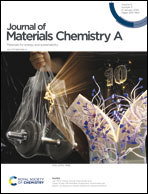Low-temperature rapid UV sintering of sputtered TiO2 for flexible perovskite solar modules†
Abstract
Perovskite solar cells (PSCs) have attracted considerable attention because of their outstanding photovoltaic performance and low fabrication cost. Conventional TiO2 ETL preparation methods require high-temperature annealing (>450 °C), which increases the fabrication cost and limits application on flexible substrates. To overcome these drawbacks, we propose a method for fabricating thin TiO2 films via sputtering at room temperature without thermal annealing. We systematically investigated the effects of the sputtering parameters, ultraviolet (UV) treatment, and thermal sintering on the properties of TiO2 ETLs for PSCs. With proper UV treatment, the sputtered TiO2 films exhibited well-matched band alignment, defect reduction, and improvements in the carrier concentration, electron mobility, and hole-blocking ability compared with thermally sintered TiO2 films. We also fabricated large-area perovskite modules using sputtered and UV-treated TiO2 films as ETLs on rigid and flexible substrates, and they had maximum power-conversion efficiencies of 18.82% and 14.61%, respectively. This study provides a simple, low-temperature route for fabricating ETLs for flexible perovskite solar modules.



 Please wait while we load your content...
Please wait while we load your content...